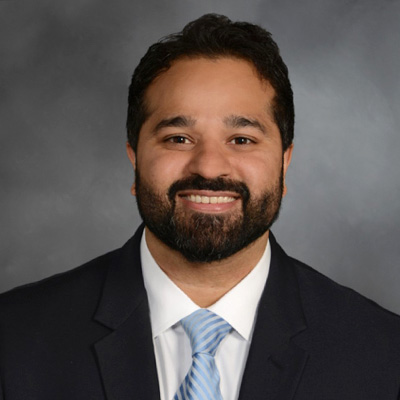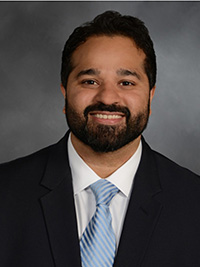
Ibrahim Hussain, MD
The orthopedic and neurological spine surgeons at Och Spine at NewYork-Presbyterian are known for their innovative approaches to care, from simple to complex spine issues. Ibrahim Hussain, MD, a neurosurgeon at Och Spine, is an example of that commitment to innovation. In late 2022, Dr. Hussain performed the first 3D navigation-guided endoscopic transforaminal lumbar interbody fusion (TLIF) in New York City.
“A technological revolution in spine surgery is underway and has already had dramatic effects on the quality of care delivered to patients,” says Dr. Hussain, an Assistant Professor in the Department of Neurological Surgery at NewYork-Presbyterian/
TLIF is a long-established procedure for treating lumbar degenerative pathologies including degenerative disc disease with instability and spondylolisthesis (“slipped vertebrae”). The procedure uses an access route through Kambin’s triangle, a section of the spine that typically requires a partial or total facetectomy to access the space.
Since the early 1980s, advances in operative techniques and image-guided surgical technologies have enabled surgeons to adopt increasingly minimally invasive approaches to TLIF.
— Dr. Ibrahim Hussain
“Since the early 1980s, advances in operative techniques and image-guided surgical technologies have enabled surgeons to adopt increasingly minimally invasive approaches to TLIF,” explains Dr. Hussain. “Traditional, or open TLIF, is highly effective, but it requires a longer incision and more extensive muscle dissection, resulting in blood loss, increased reliance on postoperative narcotics, and extended recovery times. Minimally invasive TLIF, which leverages tubular or screw-based retractors, involves a smaller incision and an oblique trajectory through natural muscle planes, but still requires bone drilling and resection to achieve the same goals to open TLIF. The ultra-minimally invasive approach, 3D endoscopic TLIF, involves a smaller incision (under one inch per level), does not require bone resection in most cases (or minimal shaving in those with very arthritic joints), and there is less muscle dissection. In some situations, it can be performed in patients awake (using monitored anesthesia care (MAC), or moderate sedation), without the use of general anesthesia.”
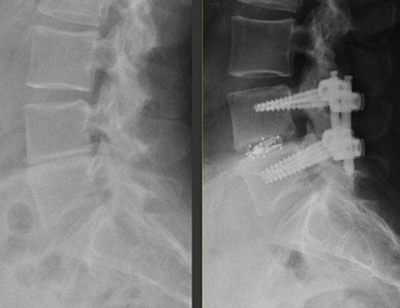
Preoperative and postoperative X-rays
For Dr. Hussain’s patient, an active woman in her 40s with advanced disc degeneration, 3D endoscopic TLIF was an ideal option. “This patient was very symptomatic, and she failed physical therapy, injections, and medications, so this surgery was the last hope for her,” says Dr. Hussain.
During the procedure, an intraoperative CT scan of the patient was obtained once positioned, and 3D reconstruction was uploaded into the computer navigation system. Dr. Hussain made a one-centimeter incision and performed a discectomy and the placement of a collapsed interbody “cage” that was bidirectionally expanded once inside the disc space under endoscopic visualization and with 3D navigation guidance.
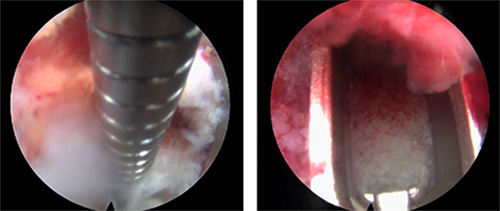
Left: Performing the discectomy and disc preparation using modified extended and flexible instruments designed to fit through the endoscope.
Right: A close-up view of the interbody cage after placement and expansion with packed bone graft in the center to facilitate fusion. (Images courtesy of Dr. Hussain)
“3D navigation helps you map out a safe trajectory that avoids nerve injury and helps plan and customize the size of the implant,” says Dr. Hussain. “It is especially useful in larger patients or those with advanced scoliosis or deformities, where traditional X-ray guidance is limited. It dramatically increases accuracy and decreases complications, so it an extremely useful tool in endoscopic fusion surgery.”
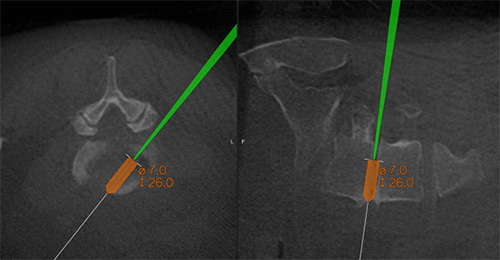
3D-navigation-guided trajectory mapping and planning and sizing of implant
Dr. Hussain’s patient had an uneventful recovery and returned to her usual activities within six weeks postoperatively. “Patients tend to bounce back quicker from this procedure,” says Dr. Hussain. “But I’m still conservative and we’re still researching how to optimize outcomes following this procedure, so I usually ask patients to recover for six weeks before resuming their activities as I would with a traditional MIS TLIF.”
The 3D endoscopic TLIF is appropriate for patients who have failed conservative treatment options and have quality of life issues related to pain or neurologic issues. “I still frequently perform open and MIS TLIF. However, for the right patients, 3D endoscopic TLIF is an ideal alternative to these more invasive approaches,” says Dr. Hussain. “We’re offering the very smallest of incisions, short times under sedation, and quick recoveries with less pain.”
“However, candidates for 3D endoscopic TLIF are much narrower to begin with than are candidates for open and other minimally invasive TLIF,” he continues. “This is because the majority of patients who need spinal fusion also have advanced arthritis, and many of these patients require the removal of bone or multi-level procedures. In endoscopic surgery we’re not taking off bone; for bone to come off, you must perform open or minimally invasive TLIF. As a result, for 3D endoscopic TLIF, we’re targeting patients who tend to be younger and haven’t developed advanced arthritis yet.”
Actively involved in the development of state-of-the-art intraoperative technologies that aim to make surgeries safer and less invasive, Dr. Hussain hopes to further refine 3D endoscopic TLIF surgery. “The hardest challenge in performing this surgery is achieving a bony fusion across the disc space,” he explains. “In open or other minimally invasive TLIF, there is so much more access to the disc space, so you can prepare the space and give it the optimal environment for the cage to integrate and grow into bone. In 3D endoscopic TLIF, you don’t get the same access to prepare the disc space, so the question right now is if — long-term — fusion success rates for 3D endoscopic TLIF will approach that of minimally invasive or open TLIF.”
For Dr. Hussain, NewYork-Presbyterian is the ideal setting to advance innovative spinal surgery techniques. “I was fortunate to have learned the procedure from one it’s pioneers, Michael Wang, MD, at the University of Miami during my fellowship. At NYP, the leadership here, including Dr. Roger Härtl, Chief of Spine Surgery at NewYork-Presbyterian/Weill Cornell Medicine and Co-Director of Och Spine, and Dr. Philip E. Stieg, Chairman of Neurological Surgery and Neurosurgeon-in-Chief of NewYork-Presbyterian/Weill Cornell Medicine, have created an environment where they are open to disruptive technologies and pushing the envelope with innovative and incorporating them into the system,” said Dr. Hussain. “It’s very gratifying to contribute to the field of neurosurgery and further its growth through my research and teaching the next generation of surgeons. I am thrilled to train our residents on the most cutting-edge techniques and technologies for spine surgery that improves our patients’ health and quality of life."



